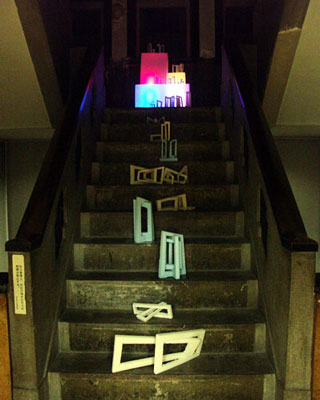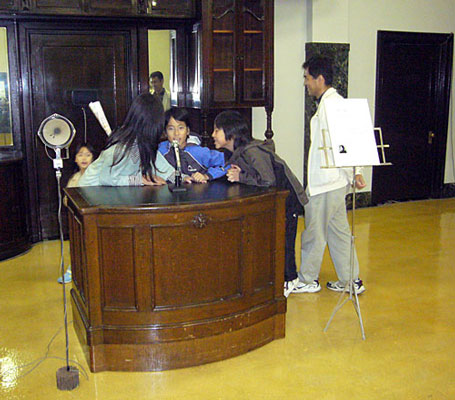KOKAIDO ART SHOW 2007
October 6, 2007

"Journey Home"
Kate Thomson
materila; styrofoam, sunplysheet, LED

"Kokaido Ghost Maschine"
Hironori Katagiri
material; micrphone, 9 speakers, computer, DVD player, sound system
| artist | 10 Iwate based artist showing site specific installations Hisashi momose, Takeshi Honda, Megumi Honda, Minako Ishikawa, Shinichi Mori, Takuya Okada, Shihoko Kobayashi, Noko Chiba, Kate Thomson and Hironori Katagiri |
|---|---|
| place | Iwate kokaido City Hall 11-2 Uchimaru, Morioka, Iwate, Japan tel: 019-623-4681 opening party 10/6 4:00~ 6:00pm |
| date | 6 - 21st October 2007 |
The meeting of art and architecture in Iwate
By KATE THOMSONThe concept of architectural heritage is still new to Japan, but sometimes a building holds so much history for local citizens that they refuse to let it be forgotten.
The 1927 Art Deco Iwate-ken Kokaido (Iwate Prefecture Civic Hall), designed by Dr. Koichi Sato (who also did the Hibiya Town Hall), acted as Iwate's main cultural center until, like many old buildings in Japan, it was made redundant by more up-to-date public facilities in the 1970s. Located in the center of Morioka City, it was a prime candidate for redevelopment, and the hall was declared "dangerous" by the prefectural government in 2000.
Local architects who valued the it for its record of the transition from modern to contemporary design voluntarily surveyed it and proved that it was actually still safe for public use. Together with the Kokaido Kenmin Forum, a citizens' group dedicated to preserving the hall, they successfully persuaded the government to designate it as a piece of historical architecture.
But how to put it to good use and ensure its preservation? One of the forum's members, the sculptor Hironori Katagiri, enlisted eight other Iwate-based artists (including myself) to use one room each for site-specific installations. The challenge was to get Iwate residents to reassess the building's potential. The artists themselves would benefit from the opportunity to develop new ideas, and alternatives to the "don't touch" work on pedestals in white-box galleries.
The result was the Iwate Kokaido Art Show 2005, an experimental project that provided a joint stage on which to present both this cultural asset and the work of contemporary artists who are aware of Iwate's cultural and social climate.
Most of the participants picked up on the idea of collaboration between art and architecture. Megumi Honda created a public living room where people could relax in armchairs while handling her small, abstract sculptures, investing the art with a rich patina of social contact similar to that of the structure itself.
Takuya Okada filled the largest room with 200 bamboo poles, creating a hybrid of architectural and organic space in which visitors could explore abstract composition. Kazue Sato used raw building materials to create a poetic space that would evoke the internal structure of memory. And I invited four young architecture students to collaborate with me on a maze of frames covered with cuttings from English, Korean, Arabic and Japanese newspapers, intended to reframe the space in an international context.
Four artists researched local history. Takeshi Honda, discovering the hall was funded by ordinary citizens, created a series of houses made of rice -- a former currency -- and "colonized" the corridor and staircase with these symbols of shelter and community. Shinichi Mori aimed to capture the passage of time and fading memory with a tower from which flowing water eroded the surface of photographs that showed the current state of the exterior and interior. And Minako Ishikawa affixed transparent transcripts of old newspaper articles about the building on a delicate checkerboard structure traversing the space.
Hironori Katagiri, meanwhile, used the "special room" Emperor Hirohito stayed in during his five-day stay in 1928 for a sound work titled "Embracing Defeat." Cambodian, Chinese, Korean, Malaysian, Indonesian and English translations of Hirohito's World War II surrender speech echoed around the original Japanese recording. Of course, this piece took on particular relevance on Aug. 15, the 60th anniversary of the end of the war.
Dismantling our works at the end of the show, few of us expected we would be able to sell them -- they really needed to be seen within the atmosphere and context of the place to be appreciated. Some works could be recycled in a different form for a different venue. Some, like Hisashi Momose's prints and others' "test" pieces that would not normally be shown in commercial galleries, were sold in a public auction on the last day. Thirty percent of the total 1.8 million yen raised was contributed by the artists to subsidize the running of the show.
Five temporary cafes set up on the sidewalks provided relaxed venues for conversations between the artists and the public. Showing that art is not a packaged answer but a catalyst for open debate, discussions covered historical, social and cultural issues raised by the art works and the site, the possibilities for collaboration between artists and society, and how to restore or modernize a threatened structure for flexible public use.
Many expressed a desire for the Kokaido Art Show to become a regular fixture, excited about the potential of developing it to enhance the image and appeal of the region to visitors from further afield. One visitor, a medical researcher, told me that "the Kokaido Art Show is a great example of how coordinating individual efforts into a whole can create one rich artwork which involves viewers in the artistic collaboration."
An extensive program of live music, dance and video performances also helped to attract over 4,600 visitors, many of whom confessed to never having been interested in contemporary art before. One 80-year-old attendee said, "Contemporary art is usually difficult to understand, but when I saw the dancing and heard the music I realized it was just like that -- a lot of fun making something new from the history of all that has gone before."
The Japan Times: Aug. 24, 2005